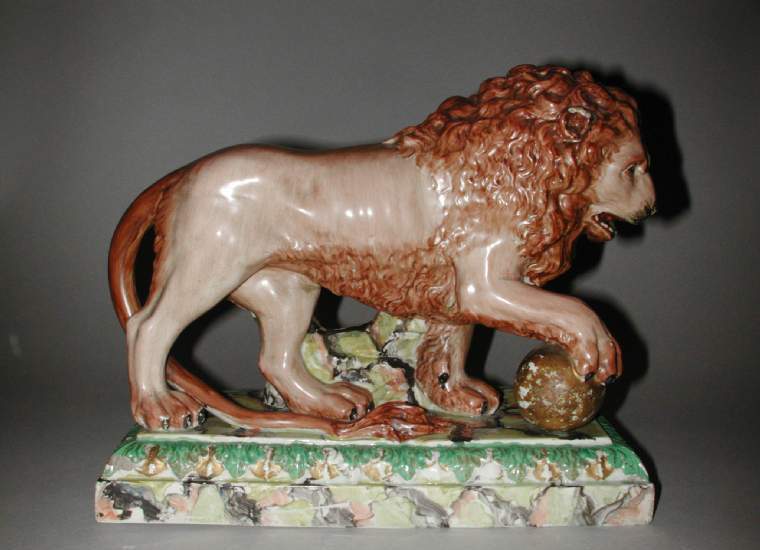Current Location: Gallery 27 (Glaisher)
Titles
Lion
Maker(s)
Factory:
Wood, Enoch
(Possibly)
Factory:
Wood & Caldwell
(Possibly)
Entities
Categories
Description
Earthenware figure, moulded with modelled additions, lead glazed, painted with polychrome enamels and gilded.
White earthenware, moulded, lead-glazed and painted overglaze in blue, green, yellow, brown, red-brown and black enamels, and cold gilding. The lion stands on a separately-made rectangular base with a border of acanthus leaves in relief. Its right forepaw rests on a ball, and its body is supported in two places by a rock. The lion is painted naturalistically in brown, red-brown and black, the base and rock are marbled, the acanthus moulding is picked out in green and gold, and the ball is gold. The underside is recessed and glazed; a central wall makes two squares, in one of which is a round vent hole.
Notes
History note: Unknown before donor
Legal notes
Given by R. Addis
Measurements and weight
Height: 25.2 cm
Length: 31.2 cm
Width: 15.2 cm
Acquisition and important dates
Method of acquisition: Given
(1983)
by
Addis, R.
Dating
18th Century, Late
Circa
1790
CE
-
1810
CE
Note
Pearlware figures decorated with enamels were in production by 1780. They were generally made at smaller potteries, drawing on a variety of sources, including sculpture and porcelain figures, and are rarely marked. Classical, biblical, mythological and literary subjects were popular. Earlier figures are moulded, perhaps with moulded or modelled parts added, the bases often formed separately. After around 1810-1820, they are often more vibrantly coloured and by c.1835 three-part press-moulding had largely taken over, enabling cheaper and faster production for a growing market.
The model for this lion figure is a 2nd century Roman figure which stands at the entrance of the Loggia dei Lanzi in Florence with a companion sculpted by Flaminio Vacca in 1594. The ancient lion was originally sculpted in high relief and was cut from its ground in 1591, which perhaps account for the ‘marble’ support between the right legs here. The lions were moved from the gardens of the Villa Medici in Rome, to Florence, in 1789. Small scale reproductions of these, in stone, marble, plaster or bronze, circulated widely and may have been the source for earthenware lions, which were produced in pairs and perhaps placed at opposite ends of a dresser or bookcase. This is the most accurate of several Staffordshire lions in the Fitzwilliam Collection.
School or Style
Neoclassical
People, subjects and objects depicted
Components of the work
Decoration
composed of
enamel
( blue, green, yellow, brown, red-brown and black)
gold
Materials used in production
blue-tinted
Lead-glaze
white
Earthenware
Techniques used in production
Lead-glazing
Moulding
References and bibliographic entries
Related exhibitions
Identification numbers
Accession number: C.36-1983
Primary reference Number: 74682
Stable URI
Audit data
Created: Saturday 6 August 2011
Updated: Tuesday 30 April 2024
Last processed: Thursday 14 August 2025
Associated departments & institutions
Owner or interested party:
The Fitzwilliam Museum
Associated department:
Applied Arts





